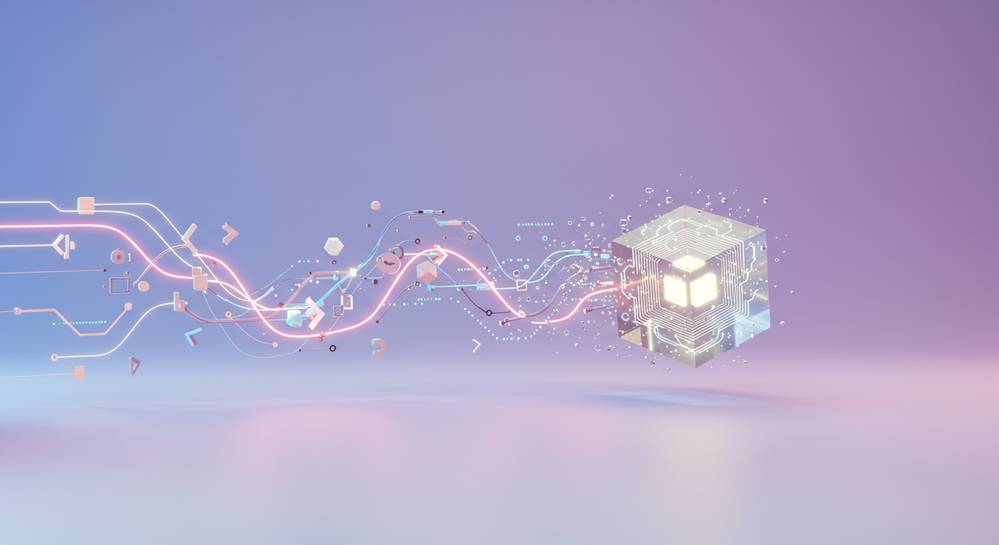As we look beyond current trends and uses, one question stands tall: What is the future of blockchain technology? It’s a topic that’s not just for tech geeks anymore but pivotal to everyone’s future. From the evolution of blockchain infrastructure to its potential in transforming various industries, we will dive deep into what lies ahead. Get ready for a journey through the developments and challenges that blockchain faces to become more sustainable, secure, and versatile. Let’s explore together how blockchain could change our world for the better. Buckle up; it’s going to be a thrilling ride.
Exploring the Horizon: What’s Next for Blockchain Tech?
The Evolution of Blockchain Infrastructure and Protocols
Blockchain tech is growing fast and getting better every day. This is because smart people are always thinking of new ways to make it stronger and more useful. Like building a bigger and better playground, blockchain is expanding so more friends can play, faster and safer. One cool way they’re doing this is with Layer 2 Scaling Solutions.
Implementation of Layer 2 Scaling Solutions
Think of Layer 2 like an express lane on a highway. On a normal road, cars can get stuck in traffic and it takes longer to get where you’re going. But with an express lane, cars can zoom past the traffic and reach their spot in no time. Layer 2 does this for blockchain. It lets more people do stuff at the same time without slowing down.
This magic happens because Layer 2 moves some work off the main path. It takes care of lots of transactions all at once, apart from the main blockchain. Later, it updates the main blockchain in one go. This means less waiting and lower costs for everyone. It’s a big deal for games, trading, and all kinds of apps on the blockchain.
Some say this could change things like buying gum with crypto money. Imagine buying it at the store with digital coins without waiting or paying extra fees. That’s one kind of future we’re heading towards with blockchain.

Embracing Proof of Stake over Proof of Work Mechanisms
Another super important change is from Proof of Work to Proof of Stake. You’ve heard that some folks worry about how much energy blockchain uses. Proof of Work is a big part of that. It’s like a bunch of miners all digging for gold, using lots of tools and trucks. It’s hard work and eats up a lot of power.
Proof of Stake is more like having a magic key that lets you into the treasure room if you promise to be good. It doesn’t take much energy to make the promise, so it uses a lot less power overall. Also, it’s fairer because you don’t need a big computer to join in.
With Proof of Stake, folks have to show they own a piece of the blockchain to help run it. So, instead of using energy to guess solutions, like in Proof of Work, they use what they already have. They get rewards if they follow the rules. If they don’t, they can lose their piece. It’s a trust system that uses less energy and is better for our planet.
Right now, we’re watching all this change happen. Coins that people use every day are starting to use Proof of Stake. It’s like taking the bus instead of everyone using their own car; it’s a lot cleaner and easier for the air we breathe.
These changes are huge. They’re going to make blockchain more like a super tool that we can use in all areas of life. I’m excited to see where it’s going and how it’s going to help us all connect, trade, and share in smart and safe ways. Blockchain is not just about internet money anymore. It’s about a smarter world where we can all play a part.
Blockchain Diversification: Beyond Cryptocurrency
Revolutionizing Traditional Industries with Blockchain Integration
Imagine a world where fake meds don’t make it to the store. Or where you could trace the journey of your apple from the farm to your hand. It’s not a dream. It’s what blockchain can do. It keeps info safe and makes sure it’s real. Take healthcare, it’s not just about sick visits anymore. Blockchain can keep your health records safe. No more lost files or data breaches. Every doctor you see can have your history with a click.
Blockchain can also change how we buy and sell homes. It’s all about smart contracts. They are like auto agreements that make sure everyone does what they say. They can save time, cut costs, and reduce fraud. Unlike paper contracts, they’re hard to mess with, giving more trust to big deals.
And that’s not all. Farms can use blockchain too. It offers clear info on where and how your food was grown. This is huge for supply chain transparency. It means better safety and less waste.
Expanding Horizons: NFTs and the Gaming Industry
Video games are more than child’s play. They’re big business. Now, with NFTs, or “non-fungible tokens,” gamers can truly own game items. Think swords or costumes that can sell for real cash. But it’s not just for the fun of it. It’s a new way for people to make money. NFTs in games can also mean big things for artists and creators. It opens up ways for them to get paid for their work.
Blockchain isn’t just fun and games. It’s making a real impact on the world. And this is just the start. With each day, developers work on new ideas to make blockchain faster and reach more people. This is good news for everyone. It can make life simpler, fairer, and more secure. So, when you hear “blockchain,” think beyond digital cash. There’s a whole world of use out there just waiting to be explored.

Ensuring Security and Privacy in an Interconnected Blockchain World
Enhancing Data Security with Advanced Protocols
In the future, keeping your information safe on blockchain will be more crucial. Here’s how it gets better:
- Advanced protocols beef up safety.
- These new rules make stealing data much harder.
- Picture a game where security guards always win against thieves.
Imagine this like a castle. The walls and guards are the advanced protocols. They keep the bad guys out and the treasure safe. We’re building taller walls and training smarter guards in our castle.
The Balance Between Privacy Coins and Regulatory Compliance
Now let’s talk about privacy coins and laws. It’s like walking a tightrope:
- Privacy coins are a kind of digital money that keeps your buys secret.
- But there are rules to follow. If you don’t, you could face trouble.
- It is vital to find middle ground.
Living in a society means following rules, and the same goes for using privacy coins. It’s like playing in a park. We all want to have fun, but we must do it without bothering others. These coins help us buy things secretly, but we still have to mind the rules and play fair.
Blockchain tech’s path ahead is like a river. It moves, twists, and turns. But we’re the ones steering the boat. We’re working on ways to keep your stuff safe on the blockchain. Doing this, we never forget about keeping it fair and following the rulesociety has. It’s like building a robot to clean your room, but teaching it to not throw away your favorite socks. We want blockchain to give us more without losing what we love about life now.
We’re racing towards a future where our digital world is safe and sound. You can expect blockchain to stand tall as the castle that guards our digital treasures. This castle is getting stronger day by day. It’s our job, as tech whizzes, to make sure it’s safe, easy to use, and fair for everyone – like sharing your favorite toys in the sandbox, nobody left out, nobody’s castle knocked down.

The Green Debate: Making Blockchain Sustainable
Addressing the Energy Consumption of Blockchain Systems
Let’s dive into a hot topic: how much energy blockchain eats up. Blockchain has a hunger for power. It’s like a giant game of solving puzzles, and winning takes serious computer muscle. That’s mining coins for you. Miners around the world race to confirm transactions and earn coins, using energy like there’s no tomorrow. It’s a problem, folks. We’re talking about huge carbon footprints. And we can’t just brush that under the rug.
Innovative Approaches to Cleaner and Greener Blockchain Technologies
Good news: change is in the air. Innovators and brainy folks are crafting cool solutions. Picture a blockchain that’s more like a friend to the planet. One big move? Switching how new transactions are confirmed. We’ve got this thing called proof of work. It’s the energy hog. But there’s a new kid on the block: proof of stake. It cuts down on the puzzles and saves a whole lot of juice.
Blockchain scalability solutions come into play, too. They’re like adding more lanes to our highway, making traffic – or transactions – speed by. This doesn’t just save time. It saves energy. We’re talking layer 2 stuff – things that run on top of our existing blockchain, making everything snappier. We’ve also got smarter contracts and ways to deal with our money (that’s decentralized finance, by the way) that could turn things around for energy use.
And while we’re cleaning up energy use, we’re also pushing for clarity on rules (those are the regulatory challenges) and making sure more businesses get onboard. We’d love to see our daily stuff – healthcare, supply chains, even how we vote – get a blockchain boost. That’s because blockchain can make things more honest and easier to follow. Plus, it’s great at keeping out the sneaky folks.
Smart contracts are tightening up things like how we buy houses or track our fresh veggies from farm to table. Imagine a world where you always know where stuff comes from. That’s transparency, and it’s just a slice of what blockchain can do. Security for our data? Imagine locking it up tight with blockchain. Tokenizing stuff, so things like your favorite songs become digital collectors’ items? It’s happening. And that’s not all.
Folks are talking about how everything can talk to everything – things like your fridge ordering milk when you run low. That’s blockchain and IoT making life smoother. And it all circles back to using energy smarter. If we get this right, we can have all the cool blockchain toys without the guilt of hurting our planet.
So, where are we heading? A future where blockchain doesn’t just mean more coins but a way to live cleaner and meaner. We’re shaping a world where blockchain supports our lives without leaving a giant carbon boot print on Earth’s face. And that, friends, is a future worth building.
In this post, we dived into the latest crypto tech. We explored how layer 2 solutions make things faster and why many prefer proof of stake today. We also saw blockchain’s reach stretching far beyond just cash. It’s shaping up whole industries and even games with NFTs.
Our talk didn’t stop there. We tackled the big issue of keeping your data safe and private in this growing blockchain world. Finding the middle ground with rules, yet keeping your info locked up tight, matters lots.
We capped it off by going green. It’s a hot topic — cutting down blockchain’s huge energy use. We’re seeing cool, new ways to make these systems cleaner for our planet.
To wrap it up, blockchain is fast changing and it’s doing so much more than just powering money. It’s retooling security and privacy, and even stepping up for the Earth. It’s a thrilling ride, and I’m here to guide you through every twist and turn. Stick around. The future’s bright, and blockchain’s just getting started.
Q&A :
How is blockchain expected to evolve in the next decade?
Blockchain technology, being in continuous development, is expected to see significant evolution in the upcoming decade. This evolution is anticipated to range from advancements in scalability and interoperability to broader adoption across various industry sectors. Experts predict that blockchain will become more user-friendly, and its applications will extend far beyond cryptocurrencies, impacting areas like supply chain, healthcare, financial services, and more.
What are the emerging trends in blockchain technology?
The emerging trends in blockchain technology include the rise of Decentralized Finance (DeFi) platforms, which aim to reinvent traditional financial services on blockchain networks. Another trend is the growth in Non-Fungible Tokens (NFTs), offering a new way to represent unique digital ownership. Additionally, there is increased interest in developing more eco-friendly blockchain networks, which consume less energy and have a reduced environmental impact.
Can blockchain technology be the backbone of a new internet structure?
There is a theory that blockchain technology could form the basis of a new internet structure known as the decentralized web or Web3. This new iteration of the internet would utilize blockchain’s key attributes, such as decentralization, transparency, and immutable records, to create a more secure and privacy-focused online experience. It could provide a platform where data is stored in a decentralized manner, reducing the risk of data breaches and increasing user control over their data.
What industries could be transformed by blockchain in the future?
Multiple industries could be transformed by blockchain technology in the future. Financial services might see the most significant disruption, with blockchain facilitating faster and more secure transactions. Supply chain management could benefit from increased traceability and efficiency. Also, the healthcare industry could see improvements in the security and interoperability of medical records, while the energy sector could use blockchain for more efficient and transparent energy distribution.
What are the potential obstacles to the widespread adoption of blockchain technology?
The widespread adoption of blockchain technology faces several potential obstacles. These may include its complex nature, which can be a barrier to entry for non-technical individuals and organizations. Also, regulatory uncertainty and lack of standardized practices can hinder its large-scale deployment. Scalability issues and high energy consumption of certain blockchain applications, particularly with regards to proof-of-work protocols, also present significant challenges that need to be overcome.



